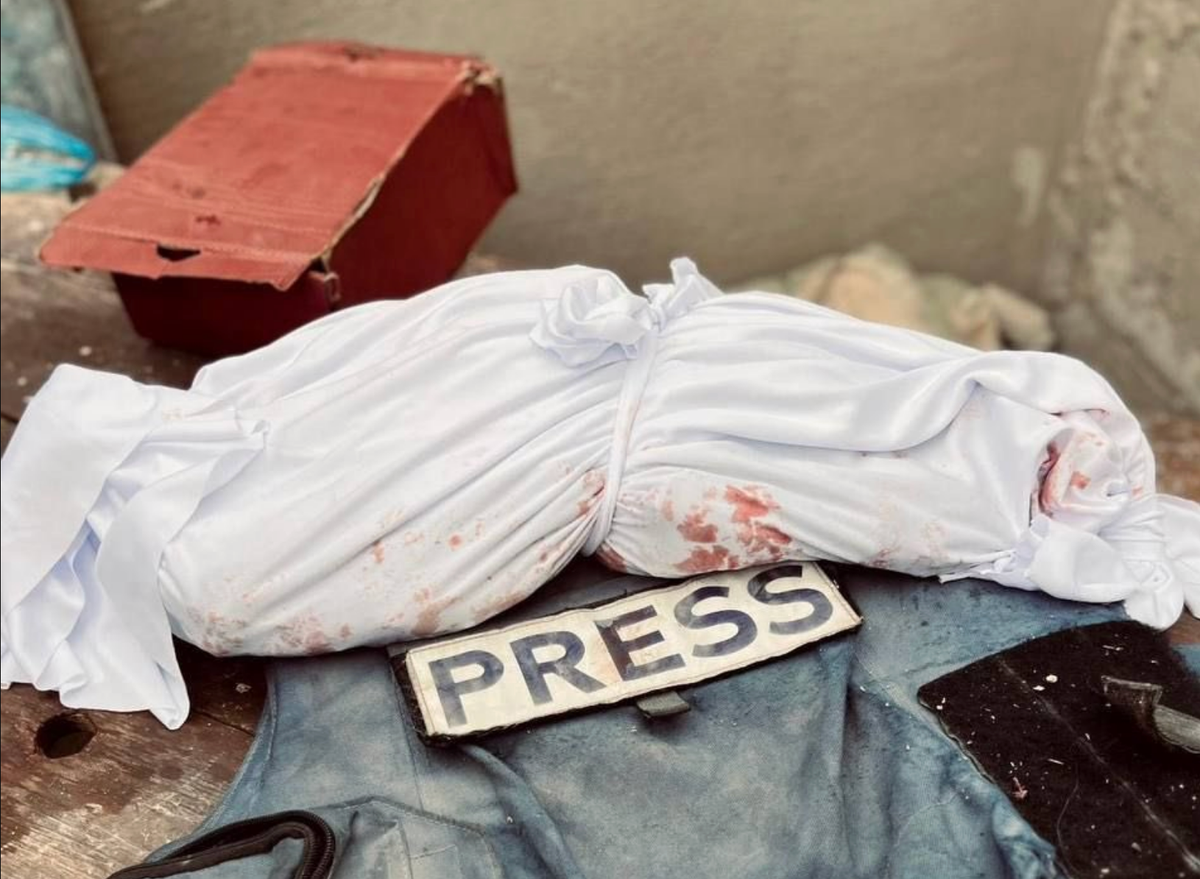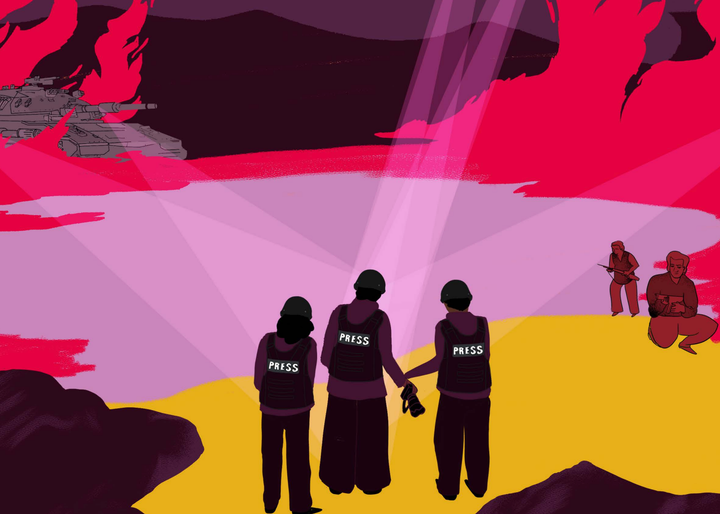US-Backed Israeli Military Forces Have Executed Numerous Journalists Since October 7
The Israeli military's campaign of genocidal violence, carried out with the full support of President Joe Biden’s administration, has killed 138-175 journalists.

The following article was made possible by paid subscribers of The Dissenter. Become a subscriber and support independent journalism on press freedom.
On October 6, Israeli military forces reportedly targeted and killed Hassan Hamad, a 19-year-old Palestinian journalist in Gaza, in his home in the Jabalia refugee camp.
Maha Hussaini, a Middle East Eye reporter in Deir al-Balah in the occupied Palestinian Territories, reported that Hamad had received threatening phone calls and text messages months ago.
Hamad had been covering an attack by Israeli troops on a residential home when he returned to his bedroom around dawn. “It’s clear [a] shell was fired directly and specifically at Hassan’s bedroom to intentionally target him,” said Ashraf Mashharawi, who manages the Media Town Production Company where Hamad worked.
As Mashharawi told Middle East Eye, his colleague had taken many photos and videos that had made headlines. “Apparently, this bothered [the Israelis]—the fact that his coverage gained attention.”
Barry Malone, the deputy editor-in-chief for the Thomson Reuters Foundation, responded, “Just saw the remains of [19-year-old] Palestinian journalist Hassan Hamad reduced to a plastic bag and a shoebox. According to a fresh tally from CPJ [Committee to Protect Journalists], 123 journalists have now been killed in Israeli strikes. If you're a journalist and you're not speaking out in solidarity…why?"
Record Number of Journalists Killed, Several Of Them Targeted For Execution
Over the past year, the Israeli military has carried out a campaign of genocidal violence with the full support of President Joe Biden’s administration, including a seemingly unlimited flow of weapons. Officials from the U.S. and Israeli governments ask the world to excuse the carnage because Palestinian fighters led by Hamas launched an attack on October 7, and to them, Hamas must be entirely eliminated.
Yet a coalition of American medical professionals who have volunteered in Gaza estimate that “the death toll from this conflict is already greater than 118,908, an astonishing 5.4% of Gaza’s population.” That estimate includes a record number of journalists killed, making it the deadliest conflict for members of the press.
“By comparison, 56 journalists were killed in Iraq in 2006 – the next deadliest year,” CPJ recalled.
CPJ’s latest figure is 128 journalists killed. Reporters Without Borders (RSF) says that more than 130 journalists have been killed. "At least 138 journalists” were killed in Palestine, Israel, Lebanon, and Syria during 12 months of conflict,” according to the International Federation of Journalists (IFJ).
After Hamad’s death on October 6, the Gaza government media office reported that 175 journalists have been killed.
It is not entirely clear why the number shared by CPJ, RSF, and IFJ is considerably lower, but it probably has something to do with how they verify whether someone was a working journalist or media producer.
Thirty-two journalists, according to information compiled by RSF, were clearly targeted for execution by the Israeli military.
One well-known example from RSF:
Journalist Ismail al-Ghoul and cameraman Rami al-Rifi were reporting for Al Jazeera in the Al-Shati refugee camp, west of Gaza City, when an Israeli strike targeted their car, killing them both, on July 31. Images released by their colleague Anas al-Sharif shortly after the strike, at around 4pm, show the two reporters killed inside a white car isolated in the middle of an empty street, visibly damaged by a direct hit. Anas Al-Sharif said the two reporters had been found decapitated. They were wearing their press vests, according to information gathered by RSF. The very next day, the Israeli army claimed to have targeted Ismail al-Ghoul, accusing him of being affiliated to Hamas. An investigation by RSF into this claim showed that the evidence was insufficient and inadequate.
'The Highest Number Of Detained Journalists In The World'
The Israeli government has also detained at least 69 Palestinian journalists, with 43 still in detention, according to CPJ. Most of the journalists detained are from the West Bank, and ten journalists have been confined under an “administrative detention law” that allows for “indefinite renewal of detention orders.” At least five journalists have been allegedly tortured and abused.
CPJ reported, “On a per capita basis, Israeli authorities now hold the highest number of detained journalists in the world in a given year over the past two decades, followed by Turkey, Iran, and China.”
A censorship regime imposed by the Israeli government has prohibited nearly 4,000 journalists from entering Gaza to report on the war, and as Israeli Prime Minister Benjamin Netanyahu encouraged, the country’s legislature passed a law to ban foreign media organizations that are deemed a “national security” threat.
The most prominent media organization to be banned was the Arabic news media organization Al Jazeera. In September, Israeli soldiers illegally raided Al Jazeera’s West Bank bureau and shut it down. But Lebanese broadcaster Al Mayadeen TV, Radio Dream, a local radio station in Hebron, and the West Bank-based J-Media were all ordered to cease their operations.
Israeli Communications Minister Shlomo Karhi, who was behind the media censorship law that targeted Al Jazeera, threatened to sanction the Israeli newspaper Haaretz for “false propaganda” The Times of Israel reported that Karhi proposed a government resolution to block “any new commercial agreements with the newspaper, halt all advertising in it even if it has been paid for, and halt any outstanding payments from being made.” But Karhi backed away from his proposal after it was denounced.
Destroying All Media Institutions
“Since October 7, 2023,” according to the Palestinian Journalists Syndicate (PJS), “Israeli forces have destroyed all media institutions in the Gaza Strip. Airstrikes have demolished 73 media facilities, including 21 local radio stations, 15 local and international news agencies, 15 TV stations, 6 local newspapers, 3 broadcasting towers, 8 printing presses, and 13 journalistic service institutions.”
PJS additionally recalled, “In the early days of the genocidal war on Gaza, the Israeli military targeted most of the high-rise buildings in Gaza that housed both local and international media offices. For example, the Al-Shawa and Al-Haseeri towers in Gaza City, which contained 15 floors of media offices, were completely destroyed by an Israeli airstrike on December 18, 2023, causing extensive damage to the surrounding area.”
To combat the systematic attacks on journalists, IFJ helped PJS establish a media solidarity center in Khan Yunis in southern Gaza. It offered hundreds of Gaza journalists a way to deal with the lack of internet and other obstacles to reporting.
“[Unions should] see it as an act of solidarity rather than of charity,” declared Eva Stabell of the Norwegian Union of Journalists, which supported the media solidarity center. “Press freedom is a global issue that concerns all journalists and media. Journalists’ safety is a fundamental part of this freedom.”
IFJ Secretary General Anthony Bellanger concluded, “The vast majority of the world's media are effectively cut off from a huge news story whose daily horrors pass them by. Their only available sources are the journalists who are members of the PJS and the IFJ, who take all the risks to film and photograph with their phones.”
“Gazan journalists are determined to tell their story, and for so long as that is the case, it is the IFJ’s duty to support them doing this in whatever way we can.”




Comments ()